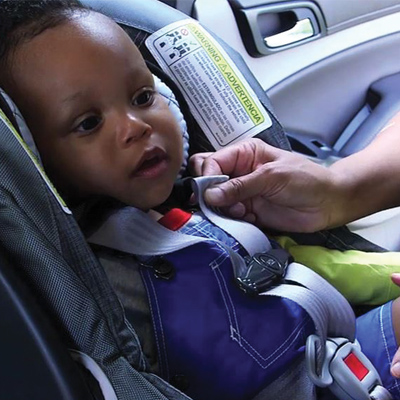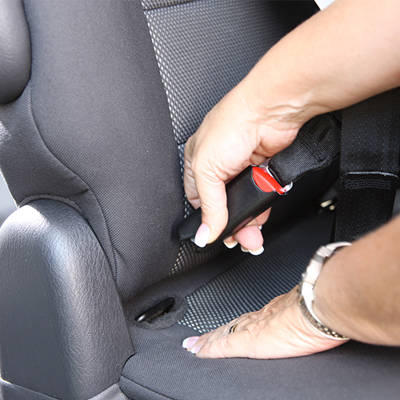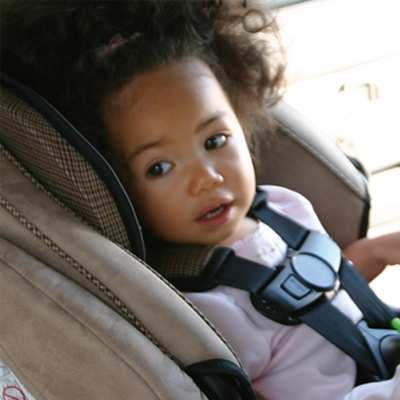You are here
Car Seat Safety Quiz

Take this quiz to test your knowledge on keeping kids safe in cars
Question 1
Rear-facing car seats are primarily for infants. Once a baby can hold up his head, a forward-facing one is fine.

Safety experts urge parents to keep children in a rear-facing seat for as long as possible. That means using it up to the highest height or weight allowed. (The car seat’s label provides that information.) Many rear-facing car seats are big enough to hold children until they are two or even older and weigh 40 or more pounds. Riding in a rear-facing car seat will help protect your child’s head, neck and spine in the event of a crash.
Question 2
By the time a child is 7, he or she is old enough to just use a seatbelt.

The fit of a seat belt is not determined by age but rather by a child’s size. Most children are not ready for a seat belt until they’re between ages 8 and 12. Parents should be aware that they will likely use three different types of car seats (rear-facing, forward-facing and booster) before a child is ready seat-belt use. This handy checklist can help you know if your child is ready for a regular seat belt.
Question 3
It’s a good idea to install a car seat in the front passenger seat so you can keep an eye on your child.

All children under 13 belong in back seat, where they are better protected from the risk of a front-end collision, the most common type of car crash. They also should be away from airbags, which can kill young children riding in the front seat. As far as what to keep your eyes on when you’re driving: Focus on the road. If you need to care for your child, pull over and take care of his or her needs. Then put the child back in the car seat, tightly buckle the harness and go on your way.
Question 4
There’s a simple test to help you determine if car seat harness is snug enough for your child.

The best way to be sure your child’s harness is tight enough is to do a “pinch test.” Once your child’s harness is buckled, pinch the webbing at the shoulders. If the webbing slides from your fingers, the harness is tight enough. If you can pinch webbing it is too loose. Keep tightening and testing until you cannot pinch anything.
Question 5
Buying a used car seat is a smart way to get you what you need – and save money.

A used car seat may be fine if, say, you got it from your brother and you’re certain that all its parts are intact; that it has never been in a crash and that it’s not expired or recalled. But you can’t know that if you buy a pre-owned seat on the internet, at yard sale or from a second-hand store. (Car seats generally last about six years, and they can get pretty beat up by their young passengers.) A new one is preferable, and it doesn’t have to cost a lot. All those on the market meet the same crash standard so, if you’re trying to cut costs, look for one without a lot of extra bells and whistles.
Question 6
There are specially-trained technicians who can help make sure your car seat is installed properly.

Safe Kids is the certifying body for the 42,000 child passenger safety technicians who work in police stations, fire stations, hospitals, GM and other car dealerships and other community locations. Technicians have been rigorously trained to make sure families leave a safety inspection safer than when they arrived. This link can help you find one in your area
Question 7
A properly installed car seat doesn’t move more than an inch in any direction.

If it is correctly installed, the car seat should not move more than one inch from side to side or front to back when pulled at the seat belt path. This rule applies to both forward- and rear-facing seats. Remember, a tight car seat keeps your child safer in a crash. For more information, use Safe Kids’ Ultimate Car Seat Guide.
Question 8
Laws in most states require you to register your car seat with the manufacturer.

A federal regulation requires manufacturers to provide a free registration card to you, but there are no laws saying you must fill it out. That said, doing so is advisable: If there is a recall, the manufacturer will notify you first and tell you what to do.
Question 9
Forward-facing car seats should be secured either by a locked seat belt and a tether or the car’s LATCH system if it has one.

Whether you use the locked seat belt and tether OR tightened lower attachments and tethers for children (LATCH system) you are properly securing your forward-facing child. Don’t use both systems (seat belt and LATCH) at the same time. (Tethers cannot be used for rear-facing car seats.)
Question 10
If kids are secured in a car seat, they’ll be safe staying alone in the car for a few minutes while you run an errand.

You should never leave a child alone in a car, even for a minute. Doing so puts kids at all sorts of risk, including the risk of heatstroke which can happen in minutes when the inside temperature of a vehicle heats up quickly. Every year, on average, 37 children die when alone in a vehicle. Learn more about what you can to prevent this from happening.
You got out of 10 answers correct.
Share this quiz:

